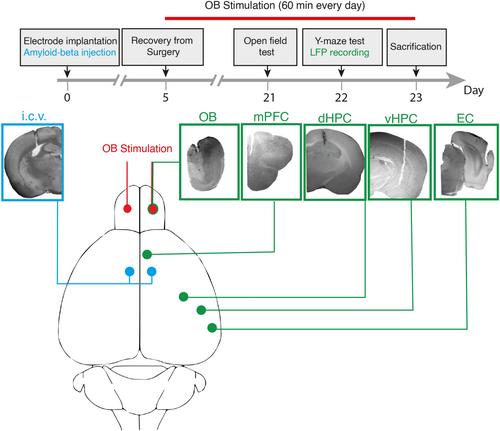Deep brain stimulation (DBS) has demonstrated potential in mitigating Alzheimer's disease (AD). However, the invasive nature of DBS presents challenges for its application. The olfactory bulb (OB), showing early AD-related changes and extensive connections with memory regions, offers an attractive entry point for intervention, potentially restoring normal activity in deteriorating memory circuits.
Our study examined the impact of electrically stimulating the OB on working memory as well as pathological and electrophysiological alterations in the OB, medial prefrontal cortex, hippocampus, and entorhinal cortex in amyloid beta (Aβ) AD model rats.
Male Wistar rats underwent surgery for electrode implantation in brain regions, inducing Alzheimer's-like disease. Bilateral olfactory bulb (OB) electrical stimulation was performed for 1 hour daily to the OB of stimulation group animals for 18 consecutive days, followed by the evaluations of histological, behavioral, and local field potential signal processing.
OB stimulation counteracted Aβ plaque accumulation and prevented AD-induced working memory impairments. Furthermore, it prompted an increase in power across diverse frequency bands and enhanced functional connectivity, particularly in the gamma band, within the investigated regions during a working memory task.
This preclinical investigation highlights the potential of olfactory pathway-based brain stimulation to modulate the activity of deep-seated memory networks for AD treatment. Importantly, the accessibility of this pathway via the nasal cavity lays the groundwork for the development of minimally invasive approaches targeting the olfactory pathway for brain modulation.



